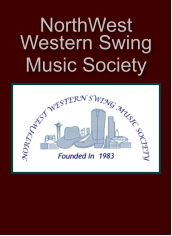
To encourage, foster and
promote the preservation
of America’s
Western Swing Music

It is through his music that these organizations have thrived. Dedication is made to Bob Wills
the first weekend in March each year, as his birthday is celebrated at Cains Ballroom
in Tulsa, Oklahoma. His hometown of Turkey, Texas, holds a Bob Wills’ Day celebration
the last weekend in April (check www.bobwills.com as well as www.bobwillsday.com for more
information on these annual events).
THE DEVELOPMENT OF WESTERN SWING
Born and raised in Alabama, Hank Penny was turned off by the relatively stilted and stodgy
sounds coming from the Grand Ole Opry and gravitated toward the freewheelin' sounds
coming from WBAP in Fort Worth. It was the band led by Milton Brown that struck Penny's
fancy, a band that played such songs as "NOBODY'S SWEETHEART", "TIGER RAG",
and "I'LL BE GLAD WHEN YOU'RE DEAD YOU RASCAL YOU".
Penny had to distinguish the vital jazz-string band combination from the Gid Tanner and
His Skillet Lickers sound coming from nearby Georgia, and so "western swing" bands
became known to Penny (and other Easterners) as "Texas Fiddle Bands." But to Texans,
that or any other term was unknown throughout the first decade of Western Swing's
existence (1932-42). It wasn't until 1944-45 that promoter Foreman Phillips actually coined
the term "Western Swing," creating a title for his star act, Spade Cooley. Cooley then
became "The King of Western Swing," in reaction to Roy Rogers' title of "King of the Cowboys."
It is ironic that Phillips would come up with the term which now defines the music whose
entire make-up is made of freedom of expression and jazz improvisation, since Phillips, himself,
put signs up at his places of exposition proclaiming "WHERE'S THE MELODY" and even went
so far as to fire one Hank Penny for instructing musicians Harold Hensley, Noel Boggs, and
Jimmy Wyble to jazz it up and ignore Phillips' edict. . . .
So, if the term "Western Swing" did not originate until after World War II, what did they call it,
the band members themselves and the people in Texas who lived with the music throughout
the depression? Unlike Bluegrass, there was no one band or bandleader who spearheaded
the audio assault on audiences. (Bluegrass taking its name from Bill Monroe's organization
in the 1940's.)
In fact, there was a different driving force in each major section of Texas, Oklahoma, and
Louisiana. In Fort Worth, Milton Brown and the Light Crust Doughboys were the kingpins.
Dallas was ruled by three bands: The Wanderers, Roy Newman and his Boys, and Bill Boyd's
Cowboy Ramblers. Tulsa had Bob Wills' Texas Playboys and Dave Edwards & The Alabama
Boys; San Antonio had The Tune Wranglers and Jimmie Revard's Oklahoma Playboys;
Houston had Cliff Bruner 's Texas Wanderers, who later invaded and conquered Port Arthur.
It was the Shelton Brothers' outfit that ruled Shreveport, along with Leon Chappelear's Lone
Star Cowboys. In other words, it was a city-by- city assault on the Southwest, with each band
holding court over its terrain like Middle-Ages warlords. In interviewing musicians from each
of the above organizations, as well as numerous minor groups, the consensus was that there
was never a name for Western Swing in the 30's, although Milton Brown and his Musical
Brownies were universally recognized as being the #1 band in the Southwest and the other
groups' inspiration.
The record companies that distributed Western Swing recordings were also at a loss to
describe the music. The three labels (Vocalion, Bluebird, and Decca) made feeble attempts
to encompass the cumulative repertoire under the banners of: "Old-Time," "Hot String Band,"
"Fox Trot," "Novelty String Band," "Hot Dance," and the like, but none caught on with the public.
The reason there was no one term to describe Western Swing in the 1930's was relatively
simple. Getting out of Texas was still next to impossible in the 30's. With the Depression
enveloping the people like a sodden blanket, airplane travel was out of the question, train travel
was too expensive, and automobile travel too arduous on the long, dusty Texas "highways" to
attempt by all except the most adventurous. Therefore, Texas was in essence a gigantic
fishbowl in which there was no escape to the "civilized" world of Bing Crosby, Paul Whiteman,
and Rudy Vallee.
The only sounds that crept in from the outside were from the radio networks and the powerful
stations beaming their signals down from Chicago or up from New Orleans. These stations
featured the pulsating sounds of jazz: Louis Armstrong, Earl Hines, and Jack Teagarden were
three of the favorites. This being the only outside influence on Western Swing, Southwestern
musicians drew from their own cultures for material and soon, the rich mixture of Blues,
Ragtime, Dixieland, Cajun, Mexican, German, Anglo-American, and Cowboy Traditions began
to churn and blend. The result was a brand of music that was so all-encompassing, so
pervasive throughout the area, that there was no need to distinguish it from any other kind of
music. It all became one. The repertoires varied from city to city, but basically? it was the same
sound. And when there is only one choice, there is no need for a label to distinguish it from
another genre. It was simply music to dance to.
The development of Western Swing was as complicated as the definition of the genre itself.
(I will be referring to the music as "Western Swing" because, despite there being no term for
the music in the 30's, it is a most befitting term today. Those that may still argue are requested
to witness whether Johann Sebastian Bach called his music of the 17th and 18th centuries
"Baroque.") ....The popular opinion today is that Bob Wills was the creator and disseminator
of Western Swing, its biggest asset and most popular bandleader. The Bob Wills story has
turned legendary, thanks to the colorful makeup of the Wills persona and his long-lasting
popularity in the Southwest and his migration to Hollywood after 1940. It is time that this
assumption is put to rest. Although Bob Wills was one of the key musicians to appear in a
Western Swing band and who later formed one of the best organizations in the Southwest,
his was not the first, nor the most listened to for most of the 1930's. He was a master
bandleader and showman, and possessed a unique talent for picking talent. Wills started out
by teaming with guitarist Herman Arnspiger as a two-man "fiddle band", playing breakdowns
and waltzes in the late 20's for house parties and other social get-togethers. The two hailed
from the counties in the Texas Panhandle which thrived on cotton rather than cattle for
economic survival. Wills was from a musical family; his father, both grandfathers, nine uncles,
and five aunts all played the fiddle and young Wills, along with his three brothers, were
encouraged to follow in the footsteps of his ancestors and take up the fiddle.
Frontier fiddling in Texas was similar to its Eastern counterpart in the Appalachian region with
its repertoire of breakdowns, waltzes and occasional rags as many Texans had migrated from
that and other Eastern regions at the turn of the century. But by the late 1920's, there were
other influences that crept into young Bob Wills' ear and soon these began to affect his
repertoire. The blacks that picked cotton in and around the Wills ranch would sing field
hollers, blues, and popular numbers during their labors and Wills' already keen sense of
rhythm was drawn to this music which was so different from the relatively stolid,
straightforward strains of Bob's ancestors. By the late 20's, Bob Wills' breakdowns were
becoming more and more danceable and partner Arnspiger began emphasizing the off-beat
in his rhythm accompaniment; the two and the four of the four-four fox trot beat that was the
rage of the Roaring 20's. Western Swing reached its key developmental stage when the two
musicians were joined by vocalist Milton Brown. An erstwhile cigar salesman, Brown was a
fan of popular jazz and blues recording artists and was an avid record listener with a
remarkable ear. (Brown band member Ocie Stockard remembered that Brown could listen to
a jazz record no more than twice before being able to memorize the jazz licks and take-offs
played in it.) After singing W. C. Handy's "ST. LOUIS BLUES" with Wills at a medicine show,
Milton Brown was welcomed in as the third member of the band.
After several band name changes, the three were joined by Milton Brown's younger brother,
Durwood, whose rhythm guitar joined Arnspiger's in furthering the insistent beat. This band
found a sponsor in the Burrus Mill and Elevator Company in Fort Worth and in 1931 became
the Light Crust Doughboys. ....It was at this point that the development of Western Swing
became an epidemic that spread like wildfire throughout the Southwest. Bands sprung up
instantaneously which purported to exploit, imitate and refine the Doughboys' sound. Record
companies caught wind of the popular new sound and, searching wildly for a way out of the
Depression sales doldrums, snatched up Western Swing bands by the armful to release
records on their new, cheaper subsidiary labels aimed at the rural market. By the end of the
decade, some 75 bands had recorded for the three major labels, a repertoire on disc of some
2000 sides.
Milton Brown split off from the "Light Crust Doughboys" in 1932, creating "Milton Brown & His
Musical Brownies"; with Bob Wills forming his own band, "Bob Wills & His Texas Playboys,"
a year later. The innovations created by Brown while no longer under the iron fist of Burrus
Mill mogul W. Lee O'Daniel were the most important and influential additions to any band in
the 1930's. The first, and some say the best, swing fiddler to play with a Western band was
Cecil Brower. Classically trained in Fort Worth, Brower was taught the art of breakdown fiddling
by Milton Brown's banjoist, Ocie Stockard. Brower soon consolidated the two styles and
developed a freely swinging, Joe Venuit-inspired style which became the cornerstone of fiddlers
in Western Swing bands. Durwood Brown was the rhythm guitarist, but thanks to the influence
of black ragtime guitarists of Dallas and Fort Worth, began to take lightning fast solos on the
guitar. The bass man was Wanna Coffman, who, to make up for Durwood's abandoning the
rhythm for take-offs was forced to reinforce the rhythm by slapping the bass fiddle a la New
Orleans and Chicago jazz musicians.
The next three additons to Milton Brown's band were vital. The first came in late 1933 when
pianist Fred Calhoun joined the Brownies. Calhoun had no hillbilly background whatsoever in
his playing, he was the first strictly jazz musician to join a Western Swing band. Calhoun was
a fan of Earl "Fatha" Hines who was then broadcasting his network program out of Chicago.
Calhoun was nicknamed "Papa" due to his affinity for the great jazz pianist and bandleader.
Calhoun soon became a favorite of dancers at Milton Brown's showplace at Crystal Springs,
just outside of downtown Fort Worth. .... In late 1934 Milton Brown added another who was to
change not only the sound of Western Swing, but the sound of Country and Western Music for
years to come. Bob Dunn brought amplification to Western Swing through the homemade
pick-up attached to his steel guitar. Dunn's electrifying wailings on the steel reflected his
experience as a trombone player and the inclusion of this novelty item (for 1934!)
revolutionized Western Swing and introduced the steel guitar to the Country Music World in
an entirely new light. ....
The final addition to Milton Brown's band was a second fiddler, a kid Milton Brown had heard
about who was playing with traveling medicine shows in the Houston area. Soon, 19-year old
Cliff Bruner was on his way to Fort Worth to be a Musical Brownie. Bruner brought an
uninhibited jazz/blues style to the Brownies that was never equalled. He never did like
breakdowns and spent years learning jazz tunes and perfecting take-offs with his friend,
mandolinist Leo Raley in medicine shows such as Doctor Scott's. ....
The Milton Brown band, with its collection of standout solo performers, each capable of taking
superb, jazz-oriented solos, combined with Milton Brown's slick, suave charisma and crooning
ability became the band of the Southwest. By comparison, Bob Wills as late as 1935 was still
struggling to form a similar outfit, collecting and discarding musicians, and finally being driven
out of Texas by W. Lee O'Daniel before settling in at KVOO in Tulsa. But by leaving Texas, Wills
abandoned it to Milton Brown. When O'Daniel left the Burrus Mills in 1935, his "Light Crust
Doughboys" were revamped through raids on the "Texas Wanderers Band" out of WRR Dallas
and Fort Worth's "Southern Melody Boys."
Each band that popped up in that crucial year of 1935 emulated the Musical Brownies by
adding a Bob Dunn-influenced steel guitar, a Fred Calhoun-influenced piano, a Wanna
Coffman-influenced bass, an Ocie Stockard-influenced banjo, a twin-fiddle lead a la the
Bruner/ Brower combination, and a crooning Crosby/Teagarden influenced vocalist, a la
Milton Brown. Although Milton Brown was killed in a tragic automobile accident in April 1936,
which splintered his band, the die had been cast. Bob Wills took over as the guiding force
behind Western Swing and with his personnel now relatively stable, easily took over as the
model for Western Swing bands.
(excerpts taken from "The Devils Box" Spring 1984 article by Cary Ginell)
ROOTS of WESTERN SWING
THE LIGHTCRUST DOUGHBOYS (1931)
Herman Arnspiger, Bob Wills, Milton Brown, W. Lee
O'Daniel.....Much of the Music is based on the Bob
Wills era. Bob Wills has been called the "King" of
Western Swing Music, entertaining all throughout the
USA with his famous "Playboys" and "Playgirls.“
History

NorthWest
Western Swing
Music Society
OUR HISTORY
As
a
non-profit
organization,
the
Western
Swing
Society
of
Seattle
was
formed
in
November
of
1983
by
a
group
of
Musicians
and
Enthusiasts
for
the
purpose
of
preserving,
promoting
and
performing
western
swing
music.
The
purpose
of
this
organization
was
and
shall
be
to
encourage
and
foster
the
promotion,
enhancement
and
preservation
of
western
swing
music,
to
broaden
the
knowledge
of
its
members,
to
cultivate
and
promote
fellowship,
and
to
make
its
members
and
the
general
public
more
responsible
to
sustaining
western
swing
music
as
a
unique
form
of
music.
This
corporation
is
organized
for
pleasure,
recreation,
and
other
non-profitable
purposes
within
the
IRS
code
guidelines
which
apply
to
our
organization.
We
came
to
organize
this
group
with
the
guidance
and
help
of
the
Sacramento
Western
Swing
Society,
and
we,
the
Seattle
Western
Swing
Society
in
turn,
helped
guide
the
Vancouver,
Canada
based
branch
Western
Swing
Music
Society
into
its
formation.
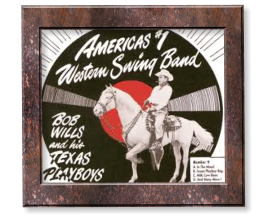

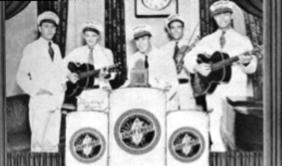

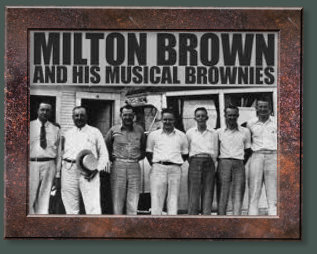
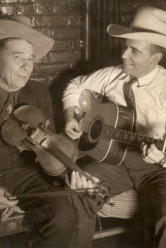

Listening Selection: Silver Lake Blues,
recorded by Bob Wills’ Texas Playboys,
Album: For the Last Time




















